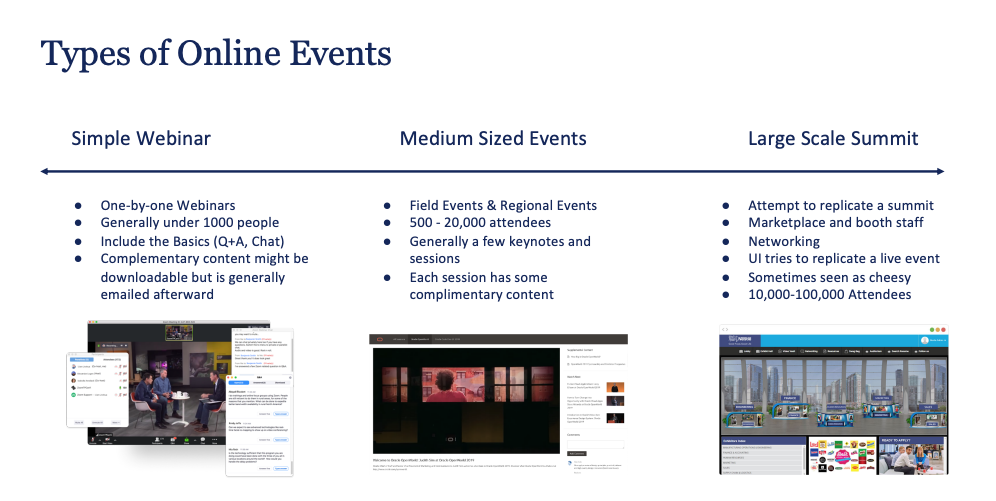PathFactory’s Virtual Event Experience (VEX) has many applications for a wide range of marketing teams. Some sessions within an event may be more well suited to a particular type of video streaming service or video conferencing tool. This article is designed to help you decide how to power the video feed for each of your sessions. Generally, there are three categories of delivering a video feed inside your VEX session: video streaming, webinars, and video conferencing tools.
Video Streaming
There are many ways to produce a live video stream. First you’ll need to decide which video streaming service you wish to use. The most common live streaming services we see are YouTube Live, Vimeo Live Stream, Brightcove and Vidyard, all of which work nicely inside VEX, though many of our customers use other tools as well. Generally most (in not all) video streaming tools work smoothly inside VEX because they are designed to be embeddable on webpages.
These platforms require a tool which will broadcast a live video stream to them, commonly referred to as an “encoder”. Many marketers will hire a production company to manage their video streams, whereas some teams will manage their own video streaming. The most common encoders we see in our customer base are:
Video streaming tools are a fabulous way to deliver a live, simulive, or on demand session. The video quality and reliability is high and they work across browsers and devices. The drawback is complexity of set-up and production. Many companies limit this complexity by hiring an outside production company to manage live or prerecorded video streams.
In addition, some PathFactory VEX customers use their existing Video conferencing technology such as Zoom or WebEx to broadcast a video conference to a live video streaming service such as YouTube Live using an out-of-the-box connector, or to Vimeo/Brightcove/Vidyard via an RTMP connection. In this way they can have multiple presenters, all presenting from home using a familiar video conferencing interface, while attendees are tuned in via a video streaming service like YouTube Live inside VEX. For more information see the Zoom or WebEx documentation on connecting a meeting or webinar to YouTube Live, or the Zoom or WebEx documentation on connecting a meeting to a video streaming service via RTMP.
Webinars
PathFactory’s out-of-the box integrations with Zoom and WebEx allow you to easily house webinars directly inside VEX, no software downloads necessary. In addition to Zoom and WebEx, GoToWebinar and BlueJeans also work inside VEX via an iframe (the URL is added to the Content Library and the webinar is displayed inside an iframe in the VEX session). The advantage to using a webinar inside VEX is the interface and controls are familiar, as well as ease of set-up for the marketer. The drawbacks are your session will be subject to the attendance limits of the webinar tool, and while the Web SDKs we leverage with WebEx and Zoom are very good, they aren’t universally supported across all browsers and devices (see notes on Zoom and WebEx). Note: some attendee’s environments are known to conflict with the Zoom and WebEx SDK. This can range from loss or audio or video to poor quality, and can be caused by any combination of Operating System, Security Setting, or Web Browser. As such we recommend that as often as possible you use Video Streaming rather than a Webinar to power the video feed in your VEX sessions.
Video Conferencing
Video conferencing is generally suitable when you require attendees to be able to share their camera, mic, or screen. For example PathFactory VEX customers running events with hands-on lab sessions might use a video conferencing tool to deliver a collaborative experience, such as our out-of-the-box integrations with Zoom Meetings and WebEx Meetings. Drawbacks to this approach include cross device and browser support limitations (see note on Zoom and WebEx), limits on number of attendees may apply depending on your video conference solution licence, and the management of muting and unmuting attendees can be a nuisance. As such we recommend that as often as possible you use Video Streaming rather than Video Conferencing to power the video feed in your VEX sessions. Unless your session absolutely must have audience members use their mic, camera, or screen share we recommend choosing Video Streaming.
How to Decide on a Video Feed for a Session
The following graphic will help you arrive at which solution is best suited to the needs of your session.

Views: 60
